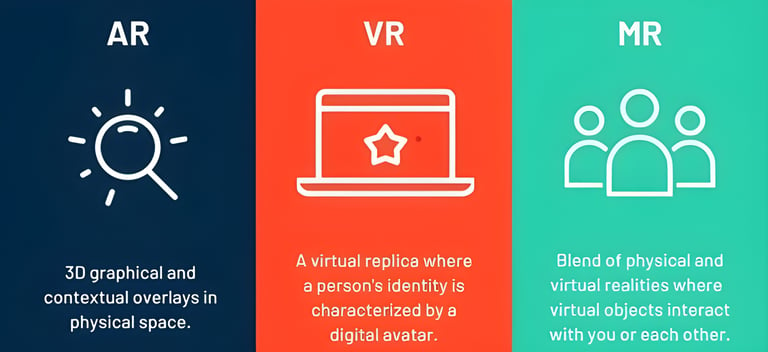Cross-Reality (XR) Campaigns: Blending AR, VR & MR for Brand Experiences
Cross-Reality (XR) is the convergence of Augmented Reality (AR), Virtual Reality (VR), and Mixed Reality (MR)—technologies that are redefining how brands interact with consumers. In 2025, XR is emerging as a powerful digital marketing tool, enabling immersive and interactive brand experiences that go beyond traditional formats. With XR, brands can create multi-sensory campaigns that allow users to engage with products and services in highly personalized virtual environments. For example, consumers can try on clothing using AR filters, explore VR showrooms from home, or interact with 3D holograms in real-world spaces using MR headsets.
6/21/20255 min read


Augmented reality enhances the real world by overlaying digital layers of information, such as images or animations, onto a user's view of their surroundings. This technology allows brands to provide interactive content that captivates users, encouraging them to explore products or services in a more engaging manner. By using AR, companies can facilitate experiences that allow consumers to visualize how a product might fit into their own lives, thereby enhancing their decision-making process.
Conversely, virtual reality immerses users in a fully simulated environment, allowing them to experience entirely new worlds that exist beyond their physical surroundings. With VR, brands can transport their audience into branded experiences that capture attention and promote engagement. Through storytelling and immersive content, businesses can create a memorable connection between the consumer and their brand, which can lead to higher levels of brand loyalty.
Mixed reality stands at the intersection of AR and VR, allowing for real-time interactions between physical and digital elements. This technology not only blends these two realms but also enables users to manipulate and engage with objects in a more meaningful way. By combining the physical presence with digital enhancements, MR provides brands with innovative ways to showcase their offerings, resulting in captivating consumer interactions.
The evolution of XR in branding has been driven by advancements in technology and an increasing demand for immersive experiences among consumers. As brands recognize the potential of cross-reality campaigns, they are leveraging these techniques to enhance customer engagement and create a lasting impact in modern marketing strategies.
Seamless Storytelling through XR
Cross-Reality (XR) technologies, encompassing Augmented Reality (AR), Virtual Reality (VR), and Mixed Reality (MR), have revolutionized the landscape of brand storytelling. By leveraging these immersive technologies, brands can create narratives that engage consumers on a deeper emotional level, enabling them to experience stories rather than merely observe them. This transformation in storytelling is facilitated through various mechanisms unique to each XR medium.
AR enriches the real world by overlaying digital content, allowing brands to blend their narrative within the consumer's environment. For example, an AR campaign might allow consumers to scan products in-store and access interactive stories that detail the origins of the product or provide additional context, thereby enhancing customer knowledge and engagement. VR, on the other hand, offers a fully immersive experience that transports users to entirely new worlds, making it easier for brands to evoke strong emotional responses. Think of a travel brand that deploys VR to transport users to exotic locations, allowing them to experience the ambience and culture of a destination from their living room.
MR combines elements of both AR and VR, enabling users to interact with digital content within the context of the physical world. This interaction fosters a profound connection to the narrative. A leading automotive brand utilized MR technology to enable potential customers to customize a car model visually and interact with virtual components, transforming the traditional vehicle purchasing journey into an engaging, personalized narrative.
Successful XR campaigns exemplify the power of seamless storytelling. For instance, one notable campaign used immersive AR to depict a compelling plotline around sustainability, allowing consumers to understand the impacts of their choices interactively. Such campaigns not only captivate audiences but also foster genuine emotional connections, establishing a memorable brand experience that resonates long after the interaction concludes.
Benefits of Integrating XR in Brand Campaigns
The integration of Cross-Reality (XR) technologies, which encompass Augmented Reality (AR), Virtual Reality (VR), and Mixed Reality (MR), offers significant advantages for brands aiming to enhance their marketing strategies. One of the key benefits is enhanced customer engagement. XR allows brands to create immersive experiences that captivate users, thus encouraging deeper interaction. Users can engage with products in a simulated environment, leading to a memorable and impactful brand experience. This type of engagement can significantly influence consumer behavior, resulting in increased interest and purchase intention.
Moreover, brands that leverage XR technologies often experience improved brand recall. According to a study conducted by the International Data Corporation, consumers retain approximately 70% more information when exposed to AR and VR experiences compared to traditional advertisements. This heightened recall is attributed to the immersive nature of XR, which resonates more with users, making it far more effective in conveying brand messages.
Personalization is another crucial advantage of integrating XR into brand campaigns. By utilizing XR, brands can tailor experiences based on user preferences, creating individual journeys that align with specific customer needs. For instance, a cosmetic brand may implement AR features that allow users to virtually apply products before purchasing, thus enhancing their shopping experience and driving sales.
Furthermore, XR provides brands an opportunity to distinguish themselves in an increasingly competitive market. As businesses strive to capture consumer attention, employing cutting-edge technologies such as XR can set a brand apart from its competitors. A successful example of this is seen with major brands like IKEA, which uses AR to allow customers to visualize furniture in their own homes, proving the efficacy of XR in transforming the retail experience.
In summary, the incorporation of XR technologies into brand campaigns not only enhances engagement and recall but also facilitates personalized experiences, enabling brands to rise above competition and foster deeper connections with their audience.
Future Outlook: The Next Wave of XR Innovations
As we look towards the future of Cross-Reality (XR) technologies in marketing, it becomes apparent that innovation and advancement will play pivotal roles in shaping brand experiences. With the rapid evolution of augmented reality (AR), virtual reality (VR), and mixed reality (MR), marketers are presented with a unique opportunity to engage consumers in ways previously thought impossible. One of the most significant drivers of change in the XR landscape will be the integration of artificial intelligence (AI) and the expansion of 5G networks, which promise to enhance XR capabilities dramatically.
The potential of AI in XR is immense, as it can facilitate personalized user experiences through data analysis and adapt content dynamically to meet individual consumer needs. For example, brands may utilize AI to analyze user interactions within XR environments, enabling them to deliver tailored advertisements or immersive storytelling that resonates with specific audiences. Coupled with the high-speed connectivity of 5G, which allows for more fluid, real-time interactions, the integration of AI could create hyper-personalized marketing strategies that foster deeper connections between consumers and brands.
However, the path to embracing XR innovations is not without its challenges. Brands must consider the implications of privacy and data security as they delve into the use of AI and real-time data analytics. Furthermore, the cost of developing high-quality XR experiences may present a barrier for some companies, particularly smaller enterprises with limited budgets. It's crucial for brands to weigh the potential return on investment against these challenges as they strategize their marketing initiatives.
In conclusion, the future of XR in marketing holds vast possibilities, driven by technological advancements such as AI and 5G. As brands prepare to navigate this evolving landscape, they must remain vigilant and informed, fostering innovation while addressing the accompanying challenges. The ever-changing realm of XR presents an exciting frontier for marketers, promising not only enhanced consumer engagement but also new avenues for creative expression and brand differentiation.
Introduction to Cross-Reality (XR)
Cross-Reality (XR) is an umbrella term that encompasses various immersive technologies, primarily augmented reality (AR), virtual reality (VR), and mixed reality (MR). These innovative technologies are transforming the way brands engage with their audiences, offering unique experiences that effectively merge the physical and digital worlds. As businesses strive to create more impactful marketing strategies, the integration of XR into brand experiences has become increasingly significant.
Contact Graphixio Today – Your Reliable Partner for Digital Marketing Services in Dehradun. Reach out to us for a free consultation and discover how our expert digital marketing services in Dehradun can accelerate your business growth.
Reach Out To Us
📞+91-7060648052
📞+91-7906148971
© 2024. All rights reserved.
Quick Links
Find Us On Social Media


Get To Know More About Us
